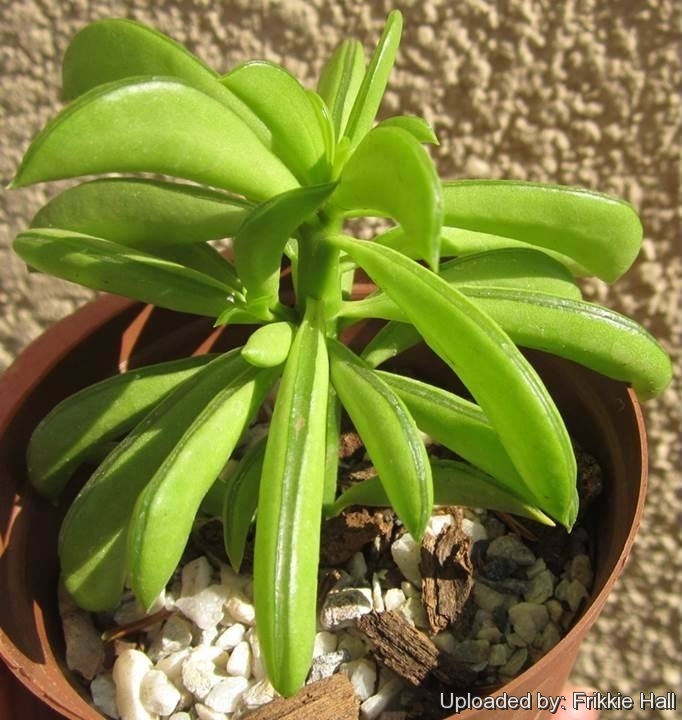




Your support is critical to our success.

Origin and Habitat: Huánuco, cuenca del Utcubamba, Amazonas, Peru (Western South America).
Altitude range: 1500—2020 metres above sea level.
Habitat and ecology: This species is forest-floor dweller native to tropical forests.
Synonyms:
- Peperomia ferreyrae Yunck.
GERMAN (Deutsch): Zierpfeffer, Zwergpfeffer, Peperomia
SPANISH (Español): Congona amarilla.
Description: Peperomia ferreyraeSN|32021]]SN|32944]] is a glabrous, succulent, epiphytic erect shrubets to 30 cm tall. The green stems bear very slender, narrow lime green leaves with a darker-green longitudinal window along their curved upper surface. Peperomia ferreyraeSN|32944]]SN|32944]] is similar is to Peperomia dolabriformisSN|32944]]SN|32021]], but with much shallower leaves with a grooved upper face.
Derivation of specific name: This member of the Euphorbiaceae family was given this name for Alejandro Huerta Ramón Ferreyra (1910-2005), Peruvian botanist.
Branches: Stiffly erect, to 1.5 cm in diameter at base, with large brownish leaf-scars. Branches scattered, 3 -5 mm thik, leafy in upper half.
Leaves. Alternate, petiole indistinct, lamina longitudinally folded with a shiny grooved window, 4-7 cm long, 3-4 mm wide, 4- 6 mm high, linear in lateral view.
Inflorescences: Narrow elongated terminal panicles to 15 cm long. Peduncle 2-4 mm long. Spike 20-35 cm, 1 mm in diameter, in groups of 1-3; bracteoles roundpeltate. Ovaries ovoid.
Bibliography: Major references and further lectures
1) Urs Eggli “Illustrated Handbook of Succulent Plants: Dicotyledons” Springer Science & Business Media, 2002
2) Tovah Martin “The Unexpected Houseplant: 220 Extraordinary Choices for Every Spot in Your Home” Timber Press, 28 August 2012
3) Urs Eggli, Leonard E. Newton “Etymological Dictionary of Succulent Plant Names” Springer Science & Business Media, 29 June 2013
4) T. G. Yuncker “South American Piperaceae: New Species and Nomenclatural Notes on Two Previously Published Taxa” American Journal of Botany Vol. 43, No. 3 (Mar., 1956), pp. 161-168
Cultivation and Propagation: The succulent peperomias, like Peperomia ferreyrae, are epiphytes and require the same treatment as rhipsalis — not that of the cactus at the right. Though peperomia produce greenish-white, panicle-like flower spikes, they are grown primarily for their foliage. They are not hard to grow but avoid over-watering. If you are looking for something different in a Peperomia, this is it. In warm, sub-tropical or tropical areas, these plants maybe grown outside as a ground cover.
Soil: Requires very porous soil with excellent drainage. This plant is a forest dweller and does best with a culture that gives excellent airflow and a soil that allows the water to run quickly away from the roots and not promote sodden conditions (best soils mix used for epiphytes). These plants like to be a little pot bound. Outdoors, grow in well-drained soil in partial shade.
Watering: You must go rather easy on the watering, however, as it is rather sensitive to over- watering. Water moderately during summer but allow to dry moderately between waterings and sparingly during winter with water that is room temperature. Though you hear that these plants favour daily misting, it is not necessary, especially if room is not overly dry. Despite being very succulent it prefers not to dry out and to remain growing throughout the year.
Fertilization. Fertilize during the growing season with a balanced fertilizer.
Exposure: Thrives in filtered light with ample airflow. Avoid drafts.. Indoors, they require bright indirect light, but do tolerate low light.
Hardiness: Not particular about temperature, but best in a moderate to warm place. Protect from frost.
Uses: They are particularly attractive at the front of the bench, or on a shelf. They are also good for windowsill culture or as an accent in dish gardens.
| Your Actions | |
|---|---|
| Back to Peperomia index | |
| Back to Piperaceae index | |
 |
Back to Succulents Encyclopedia index |
Privacy stantement - Terms and conditions - How to cite - About us - Feedback - Donate



